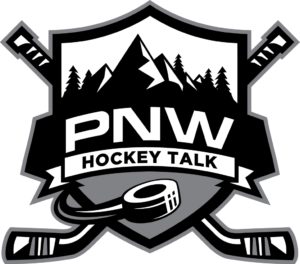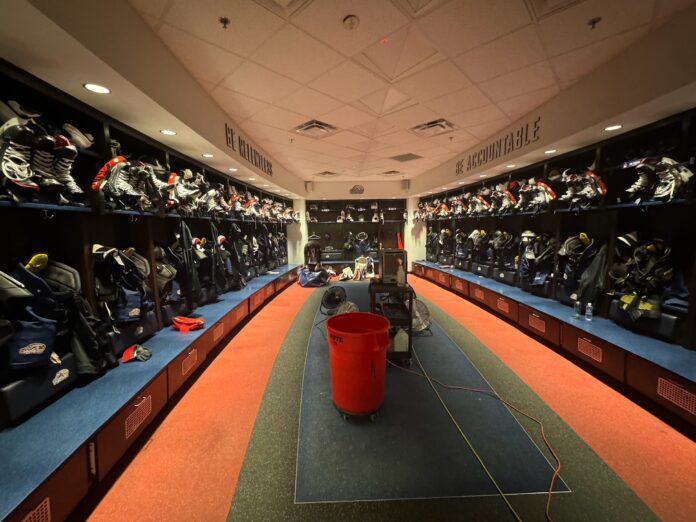
The 2024 Memorial Cup will be presented on Sunday in Saginaw, Michigan, but the preparation began long before the players, coaches, team personnel, media, fans, and sponsors started arriving last week.
With the Canadian Hockey League hosting the Memorial Cup back in an American city for the first time since Spokane in 1998, the Saginaw Spirit organization set a goal to make this a memorable tournament for all involved.
Achieving their goal presented many logistical challenges.
From the hockey operations side, enter Lester Tiu, the head equipment manager for the Saginaw Spirit. “They appointed me as the Team Services Host,” he said. “I oversee everything for the hockey operations side of the three teams coming in, whether that is their rooms, their supplies, their travel in, or their travel out. We try to think of everything because there are so many scenarios at that point.”
The Dow Event Center in downtown Saginaw needed many renovations to be ready to host three additional junior hockey teams. At the start of last summer, the Spirit was in a position to host only one.
“We started by building a new (locker room) that we could work out of while we built the other two, which was a huge endeavor for this building,” Tiu said.
The upgrades took longer than anticipated as the team ran into construction challenges, including installing professional lockers in all three rooms – something that teams may not even have at their home rink. A common theme emerged: Saginaw was going above and beyond.
Tiu mentioned the importance of being a good host. “All because the CHL has a big push to make sure this is a top-tier experience for everyone that comes in. We aren’t trying to say the host has a good setup, and you just come in and get whatever you get. The renovations were a big project, and we tried to make sure that we could stay on top of that.”
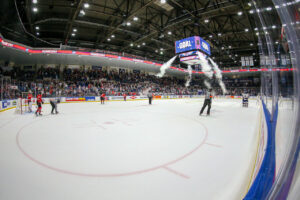
Once the renovations were completed, the next step for Tiu and his staff was acquiring all the supplies and consumables. They had the help of the CHL telling them to go above and beyond.
“We want to make this an impressive event and want teams to leave here going, ‘Wow! That was the best thing I ever experienced. They set out to make this the Super Bowl of hockey,” Tiu mentioned.
As the season progressed, the required items were obtained, but this made only a minor dent in Tiu’s list. “It really got down to the wire where we were running around buying up stuff, buying supplies from everywhere we could. In a way, getting knocked out in the (OHL) conference finals bought us a huge amount of time to say, ‘Hey, focus on getting this stuff.’ If we hadn’t, it would be very different.”
Making a positive impression
Most fans will never see the number of items required to produce a CHL hockey game. It goes beyond what is seen from the stands.
For example, the Spirit needed to acquire additional tunnels and canopies to provide the teams and officials cover as they enter the rink from the locker room area. Those items are not cheap, nor will they be needed once the tournament is over. Tiu said the cost of purchasing those items could range in the tens of thousands of dollars.
In addition to the tunnels, Saginaw also needed to acquire additional exercise bikes, medical tables, speakers, and towels. For many of those items, Tiu worked on borrowing them from other buildings, arenas, and even the Flint Firebirds. He would say, ‘Look, what can you spare for a few days for us?’ Ultimately, they brought a box truck to Flint, loaded items, and made the drive north on Highway 75 back to the Dow Event Center.
“It was a scramble, but once we got everything in place after the first day or two, we realized everything is here, and everything got really easy. It was just a matter of getting it in here,” Tiu said.

One of the items Saginaw was not able to borrow and decided to hire out was a towel service, as over 500 towels were expected to be used each day. A recommendation was given to Tiu so a company would drop off clean towels, pick up the dirty ones, and keep the rotation going, helping them avoid doing even more laundry.
“We are basically doing every team’s (laundry) twice a day. They will have a morning activity, maybe on or off the ice. We will turn around their laundry. Then, we have two teams that play at night, so we run that after the game. So that includes jerseys and socks, player’s underwear apparel, and any of the Gatorade bench towels, linens, or anything else we need to replace,” Tiu said.
Tiu was able to get additional support from other equipment managers and volunteers so each team could focus on the task at hand, winning the Memorial Cup. “Those guys came in huge and have been doing an awesome job. What helps a lot is the CHL supports that. They pushed for it and they facilitated it by getting their hotels, providing the per diem, and equipping them with everything they need to support these teams. They gave us almost free reign. It wasn’t almost no budget, but make the problems go away.”
The CHL also gave Tiu a list of consumable items such as snacks, soaps, sharpening supplies, and backup emergency equipment so they could meet the standard.
Doing the minimum was not enough, though.
“Being that Saginaw set out to make this the best Memorial Cup event that has ever been put together, our side made a push to say, ‘Lester, find ways to go above and beyond.”’
So, customized nameplates were designed, ordered, and installed in all four locker rooms. The original plan was just to put placeholders up, but logistical concerns about the size of the name bars presented an unacceptable answer for Tiu.

“We realized too that not every team does that, and not every team operates with the same size nameplates. What our President did was say, ‘Go ahead, Lester, order the six teams that are in the finals, not knowing which teams are going to be here. Order them all, and we will just use the ones that we need.’ That was an expense that (Saginaw) took on and said that is a pro touch to say, ‘We welcome you here and are excited you are here. Look, we made a Memorial Cup nameplate for you now that you’re here.’ That is something that has never been done. That is a perfect example of our business team saying go ahead and impress,” Tiu said.
On the ice, the teams are competing against one another. Behind the scenes, the equipment managers work together. Tiu said when Drummondville and Moose Jaw flew into Saginaw, the entire support equipment staff drove up to the airport, loaded the truck, drove their gear (to the Dow Event Center), and helped them unpack.
“You don’t see that. That doesn’t come through in the games, but we are helping each other make that quicker, make it easier, and further to say welcome. We will get you what you need and help you out. It wasn’t a competitive advantage at all. It was purely professional courtesy,” Tiu explained.
Once again, the Saginaw Spirit organization went above and beyond the minimum required to ensure a flawless Memorial Cup for Drummondville, Moose Jaw, and London.
Unsung heroes of the hockey teams
Equipment managers do not often get the recognition they deserve or seek out. They are the first to arrive and last to leave the rink each day. For example, Tiu has been getting to the Dow Event Center between 7:00-8:00 a.m. and may not leave until 2:00 a.m. the next day.
“A lot of it is planning for situations that may not occur, but if they do, we make that issue go away,” Tiu said when asked about how he prepares for games and supports the Spirit’s players and coaches. “We tend to carry uncommon things and things we may never use, but that need arises, having it inspires so much confidence in everyone to say we have you covered. Whatever comes up, ask me, I’ll pull that out of the magic bag and say, ‘We’ve got it covered.’ That is what people don’t realize. It isn’t so straightforward to just tune in at 7:00 and say, “Go play hockey.’ We spend all day preparing and moving and setting up and tearing down. It is a lot longer than it seems,” Tiu mentioned.
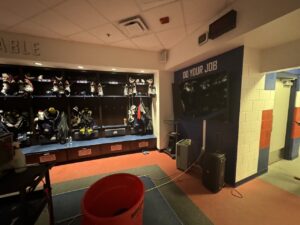
Sticks, skates, pucks, jerseys, and water bottles are some of the most common items fans will see equipment managers assisting players with.
How many jerseys does a team like the Saginaw Spirit go through in a season? “This year was special. We normally would do 50-60 jerseys. We were in the 100-120 range this year in terms of the jerseys that we had crested. Here, we don’t have a third jersey, so I will have a home and an away (jersey), but that’s it,” Tiu answered. “Being the roster we have this year, knowing that we were going to have a very deep team, we went ahead and ordered a lot of extra jerseys, knowing that there were going to be requests. These are meaningful players and trades to our coaches, our general manager, and our owner, knowing that they had a certain list of players that they wanted to have.”
The jerseys used by the teams are high quality but will still run into wear and tear. A player may rip or get blood on the jersey, so repairs are required. Each equipment manager will have his or her preference on how to get it back to game shape, but Lester prefers to sew rather than use a patch. If there is blood or another stain, he will use a peroxide or bleach product since the jerseys are synthetic fiber; it is harmless. He said he could get about anything out of the jersey and return it to where he wants it.
Next on the list are all the sticks used by a hockey team.
The number of sticks used by each team will vary based on how often they break or get chipped. Sticks are the biggest line item in Lester’s budget, but he still ensures the players have enough to make it through the season. “I’m documenting what we’ve brought in and how quickly we are issuing to a player. Generally, I will pack one per game plus one. So, if it is a one-game trip, we will take two. If it is a three-game trip, we will take four. Anyone who is pacing for more breakage, I will typically bring one or two more depending on their situation.”
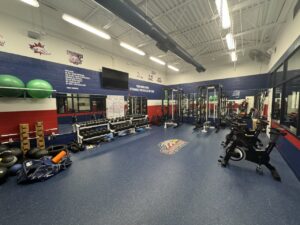
While math is involved, Tiu will also use intuition and keep an eye on how far along each stick is in the player’s typical break cycle. He also always orders more sticks for centermen and defensemen than the wingers due to faceoffs and slapshots.
On the bench, Tiu organizes the stick wall numerically from low to high so he can quickly find one should a player’s stick break during the game. Each player has two sticks on the bench. On faceoffs, he will keep a finger on the player’s stick who is taking the draw. When his team is on the power play, he has his finger on the defenseman or point-man’s stick since they are more likely to break on a one-timer or slapshot.
While a small detail, equipment managers are creatures of habit just like the players. “I like to line up their better stick to the right. I’ve found that is the easiest and quickest one to grab for some reason. So, of their two, the one on the right is the one that is coming out first,” Tiu said.
The next highest consumable in Tiu’s inventory are pucks, especially warmup pucks. The OHL regulates teams to provide 40 warmup pucks to each team, so 80 total per game. Those pucks are pre-frozen before they are set out on the bench to help prevent bouncing and increase the feel on a player’s stick. When warmups are over, approximately 50 pucks are returned when factoring in pucks handed out to fans, shot over the glass, or simply lost.

Tiu explained how short the puck life is, saying, “Whether it is lost in practice, lost in warmups, we can use the same kind of pool and everything stays pretty fresh. Very rarely do we go in there and say this puck has been in there too long. Pucks are just over the glass, and they take themselves out enough on their own.”
For the love of the game
While Tiu has been in the business for a while, he still experiences the thrill of the game being played. “The most exciting point of the day is when the lights go down and the anthems start because it goes back to when I wasn’t an equipment manager. I was just a hockey fan tuning in at 7:05, and the anthems are playing and the hockey is about to start. You know you are in for an exciting show. Being able to be on the bench, and now being basically on the TV, and seeing the lights come down, and the anthem playing with everyone singing along, and knowing this is where it happens, and I’m on the right side of it. That’s the best feeling of the day, oddly.”
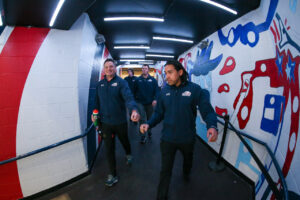
From a chore perspective, though, Tiu is energized by having an empty room and everything he needs in front of him because he knows he’s about to have an impact.
Throughout the game, in addition to helping assist with broken sticks, equipment managers need to be ready to replace a skate blade at a moment’s notice.
The technology has improved greatly over the last several years: blades can be replaced in a way that rivals a pit stop in racing.
“I haven’t timed it officially, but if I’m guessing, it could be in the 10-15 second range,” Tiu said about how quickly he can have a blade replaced for a skater. “As soon as the player has gotten onto the bench, everybody here knows to kick their feet up back at me, and I can access that skate to get the blades changed pretty quickly. It didn’t come easily. I had to cut myself a lot of times, and I still do.”
Skate sharpening and replacements can also happen during the intermissions. While fans are relaxing and catching their breath during the 18-minute break, Lester is using every second available to get ready for the next period.

“As soon as we get off the ice, I’m available to the players, and they can raise up anything,” Tiu said of what he’s doing in the locker room during intermissions. “Whether this stick has a big chip in it, let’s cut a new one. It could be changing skate blades, or it could be a stitch in the palm (of a glove), or certain equipment needs to be repaired. We have to be ready for any situation. Whether that is a helmet part being available, to general equipment like skate sharpening. We respond as quick as we can without having set up. It could even be sewing.”
When the games are not being played, Tiu is working with players on specific needs, and those requests are what excite him the most.
“I don’t come into the rink excited to fold towels and do laundry,” Tiu said with a laugh. “I come into the rink excited to solve those problems. So those I pick up quickly because once a player says I like something like this, maybe it is something I’ve seen before, maybe it isn’t, maybe it’s something we create new. When we do, those things stick with me. Those are easy to remember that he needs a new helmet, but we did this to it, or the visor needs to be in a different position. Those are the ones I get excited about. I’m all for the individuality and saying that he needs a certain thing a certain way. If they can articulate that, even better. I don’t want to say my excitement, but at least my interest, and that perseverance to get to the result, to get to a point where they are happy, that builds a lot of trust with the player that lends to a lot more communication.”
During the semi-final against the Moose Jaw Warriors on Friday, Spirit netminder Andrew Oke had an issue with one of his pads and had to come out of the game for repairs. Tiu’s expertise and poise under pressure had Oke back in the game after missing only 89 seconds of action. “He’s elite at his job,” Saginaw’s head coach, Chris Lazary, said, praising Lester’s work. “He’s been in the American (Hockey) League and was on a Calder Cup-winning team in Chicago. When I started in the league in Sarnia, him and I lived together in a house in the first year. He’s sort of been with me everywhere I’ve gone. Guys love him; he works hard, so good at his job. What I liked was there was zero panic. We were giving it to him on the bench, too, saying, ‘Hey, you’re on national TV.’ I was telling him to get on the ice and go get some milk and get on TV and let everyone know where you are. He got (Oke) back on there quick.”
While enjoying the 2024 Memorial Cup championship, give an extra dose of appreciation to those behind the scenes, like Lester, who have worked countless hours to make this the most memorable Memorial Cup.


